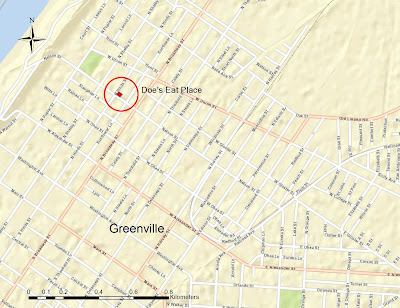
This is the fifth post on the Mississippi Delta. This is not the delta of the Mississippi River that protrudes south into the Gulf of Mexico. Rather, when most people refer to "the Delta," they are thinking of the rich alluvial plain that lies between the Mississippi and Yazoo Rivers, with Vicksburg marking its southern limit and Memphis the northern. The map above, from the US Geological Survey (downloaded from Wikipedia), shows the area. The delta has a unique cultural, racial, and economic history. Before the American Civil War, it was one of the richest cotton growing areas in the world and attracted wealthy planters, who imported black slaves to work the plantations.
According to an article in the Vicksburg Post on March 18, 2012, by Terry Rector (Warren County Soil and Water Conservation District), the Mississippi delta soils are among the most productive for agricultural crops in the country. Alluvium is the name given to river-deposited soils, which consist of minerals and materials derived from the hinterlands that form the river's drainage basin. Two common soil types found in the Delta are the Memphis Silt Loam and the Commerce Very Fine Sandy Loam. These were among the easiest for farmers to work and were the first to be converted from forest to cropland two centuries ago. When farmers referred to good Deer Creek soil, they were referring to the sandy loam soils along much of Deer Creek.
Times have changed and the Delta is now economically in very rough condition. In the late-1920s (following the great 1927 Mississippi River flood) thousands of farm workers left for the North to escape brutality, abject poverty, and racism and seek factory jobs in cities like Chicago and Detroit. Also, mechanization of agriculture, especially mechanical cotton harvesting, eliminated the jobs of thousands of farm workers. According to Wikipedia, "From the late 1930s through the 1950s, the Delta experienced an agriculture boom, as wartime needs followed by reconstruction in Europe expanded the demand for the Delta region’s farm products. As the mechanization of agriculture continued, women continued to leave the fields and go into service work, while the men drove tractors and worked on the farms. From the 1960s through the 1990s, thousands of small farms and dwellings in the Delta region were absorbed by large corporate-owned agribusinesses, and the smallest Delta communities have stagnated." As late as the 1960s, many towns like Rolling Fork, Leland, and Greenville were still active, bustling communities. But now many of these towns are semi-deserted, with empty business strips, collapsing shops, and grim poverty.

The photographs below are from Arcola, a town on Deer Creek north of Hollandale and south of Leland. The railroad once came through here, but the tracks were removed in the 1980s.
Deer Creek Drive is the main strip. All that is left is a gas station/convenience store and several lounges (or dives). Even on a sunny day the strip is depressing.
Here is another lounge. It says a lot that a small town has two drinking spots.
Here is a deserted super market on Martin Luther King Drive.
An architectural oddity: many of the shops on Deer Creek Drive were built out over the banks of the creek on brick pillars, As you can see, the floors have collapsed.
Farm houses once dotted the countryside. But now, many, like this example at 1862 Hwy 438, are deserted.
All photographs taken with Olympus E-330 and Panasonic G1 digital cameras.









